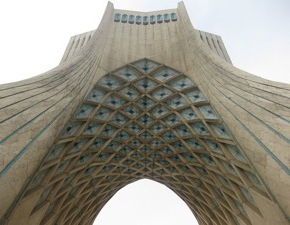Colloquial Persian

Azadi tower, the symbol of modern Tehran
Written (formal) Persian is the language used in books, newspapers, TV news broadcasts, poems, formal speeches, etc. It is the
"standard" form of the language
and its Iranian, Afghan and Tajiki versions are very similar. However, everybody uses colloquial (spoken) Persian in everyday conversations. Colloquial Persian has significant differences with written Persian, and varies from place to place. In this section, you will learn
Persian as it is actually spoken in Tehran.
The difference between colloquial and written Persian is much deeper than the difference between colloquial and written English. By the way, while understanding
a Tehrani speaking
might be difficult for a foreigner familiar only with written Persian, one must keep in mind that by learning a handful of
essential rules you can quickly fill the gap. I have presented in this section these grammatical and phonological rules as well as
differences in vocabulary between written and spoken Persian.
I have chosen the Tehrani version of Persian as the standard for this website
because it is by far the dominant spoken form of the language. With more than 8 million inhabitants, the city of Tehran by itself is well ahead of the whole of Tajikistan in population. The number of films, books, songs and blogs written and produced
in Tehran is more than the combination of all of the other cities in the Persian-speaking world. Even in other Iranian cities,
cultural products and written colloquial conversations are mainly based on Tehrani accent.
Inside Iran, other major accents are those of Isfahan, Shiraz, Yazd and Mashhad. They have faced decline since the rise of Tehran in political power 200 years ago. It is not uncommon for a Yazdi, for instance, to try to speak like Tehranis
when visiting Tehran, but the opposite case is very rare.
Isfahani accent is distinguished by its uniquely
different system of intonation. Among other famous features of Isfahani
accent are using "es" instead of the Tehrani "e" in place of the written "است" (meaning "is")
and using "i" instead of the Tehrani "e" for "ezafe".
Yazdi, sometimes confused with Isfahani by the unfamiliar ear, is characterized by its unique noun stress system.
In Yazdi, a noun's first syllabel is its stressed syllabel. In the Persian word
"کتاب" ("ketāb", meaning "book"), for example, the stress falls on "ke", while it is on "tāb" in almost all other
varieties of Persian.
A crucial point to note here is that in learning Persian, learning the colloquial form is a necessity. In order to communicate with
ordinary people, one must learn the spoken form of the language. The formal variety is well
understoond but sounds very awkward for everyday speech. Tehrani accent is fully understood and appreciated all over Iran,
and it is not unfamiliar to the ears of Persian speakers outside of Iran either.
Today, Tehrani Persian has gone beyond being merely a "spoken" form of Persian. Seeing blogs, song lyrics, movie subtitles , and
even books written in colloquial Tehrani Persian is not a surprise anymore. In fact, with the spread of technology, most Iranians use colloquial Persian more than "written" Persian
in what they write daily.